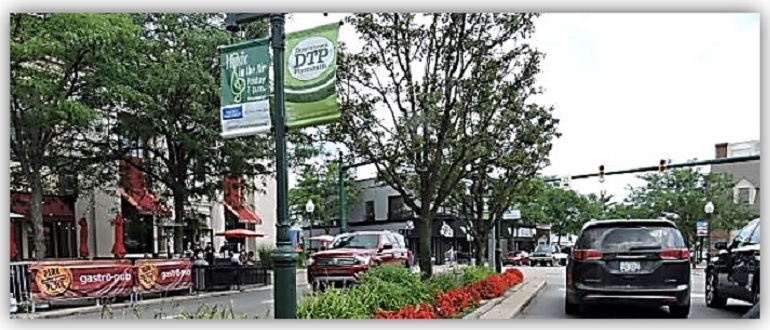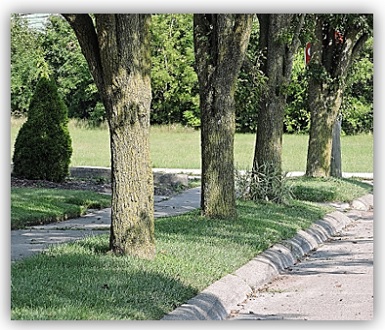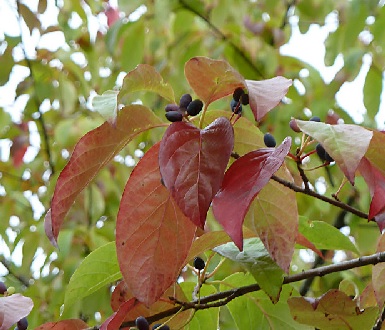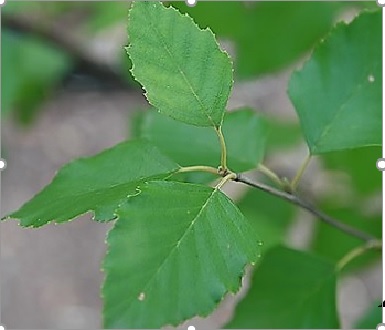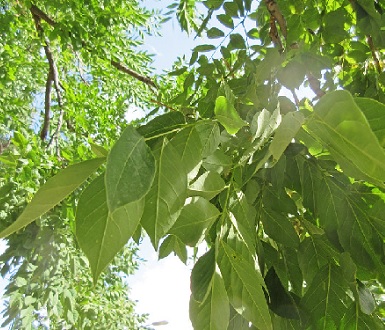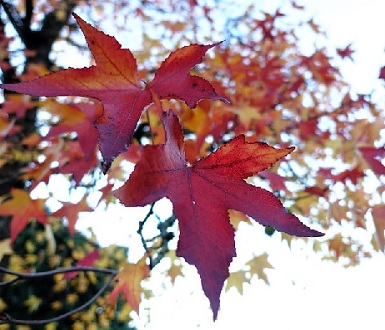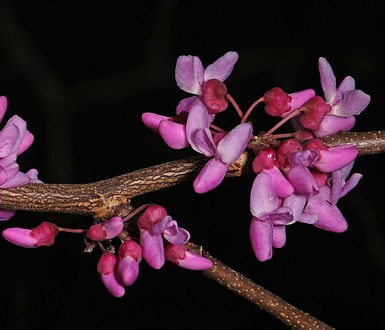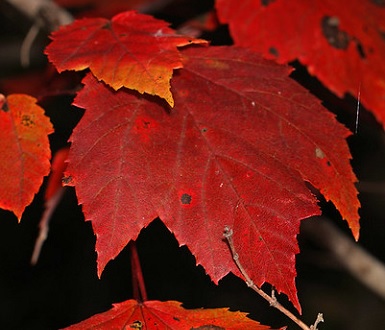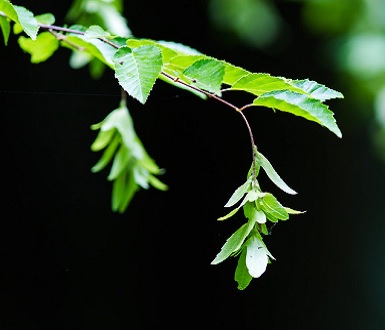Trees on Main Street in Plymouth – FOTR
GET TO KNOW
Urban Street Trees
The Rouge River watershed encompasses 467 square miles of land across 48 urban and suburban communities. It is a densely populated area that is largely covered with buildings, parking lots, and roads. Such an extensive concentration of concrete, asphalt, brick, and roofing shingles might be truly dismal if it weren’t for the majestic presence of trees. Truly, the simple presence of trees – in parks, yards, and lined up along city streets – softens the harsh edges of urban life.
FUN FACT: According to the Arbor Day Foundation Tree Facts list, an average mature tree can produce enough daily oxygen for four people and the shade provided by a tree’s branches may cool a surface by 20⁰ – 45⁰ F . See Arbor Day Tree Facts.
Urban trees – in total – are a community asset. Viewed collectively, the total mass of trees in an urban area form an “urban forest” that provides a canopy of shelter for the community.
Most obviously, trees offer visual beauty and wildlife habitat. But they also offer so much more. Studies indicate that tree canopies in urban environments improve air quality and human health while reducing overall medical costs. The roots of urban trees absorb and filter polluted stormwater run-off and help protect local waterways and drinking water sources.
Neighborhood trees also shade our homes while cooling summer temperatures and human tempers. Numerous studies have shown that neighborhoods with an abundant tree canopy enjoy overall better mental health, higher student academic performance, and lower crime rates. Additionally, an abundant tree canopy increases property values, and proper tree management programs can provide a growing job and economic sector for the future.
All in all, trees mitigate many of the problems associated with urban life, and it is to everyone’s benefit to work together to protect our urban canopy. (See the The Vibrant Cities Lab project, sponsored by American Forests ) for summaries of important research on the many benefits of urban trees.)
Unfortunately, trees in large metropolitan areas are controlled by thousands of different property owners and are generally thought of as pieces of private property. Important decisions about trees are often made by individual homeowners, business owners, and developers with little thought for the resulting effect on the overall community. The end result of such piecemeal decision making has traditionally led to patchy and insufficient tree canopies in most metropolitan areas.
In recent decades, many cities across the country have developed proactive programs for tree management known as urban forestry. The American Forests conservation group is the oldest tree conservation group in the US. This organization defines urban forestry as:
“…the planting, care and protection of trees in the urban and suburban environment. Urban forestry involves both planning and management of the urban forest because the right tree, planted in the right place, in the right way promotes the many benefits trees provide for people, wildlife, and climate.”
The need for such focused programs became critical after widespread tree losses from Dutch Elm disease (primarily the mid-1950’s through mid-1970’s) and the Emerald Ash Borer (early 2000’s). Additionally, studies focusing on uneven distributions of trees across urban areas – and the resulting effects on human health – have brought attention to a critical need to rebuild tree canopies in the poorer sections of many communities. Neighborhoods that have few trees and little to no green space, can experience a “heat island
effect where air temperatures are several degrees warmer (and surface temperatures 20+ degrees warmer) than tree-lined neighborhoods. As a result, such neighborhoods also experience higher than average heat related illnesses and deaths, greater demands for electricity and air conditioning, higher rates of air pollution.
Today, even with active urban forestry programs, most urban areas still struggle to create and maintain a full and vibrant tree canopy. In many cases, even when trees are plentiful, the canopy may include excessive numbers of non-native and invasive species, sick or struggling trees, and inequitable distributions of trees between wealthy and poor neighborhoods. The metro Detroit area is no exception; and according to a June 2021 “Tree Equity Score” (published by American Forests), Detroit needs an additional 1.2 million trees – plus a more even distribution of trees – to ensure a proper and equitable tree canopy.
FEATURED NATIVE URBAN TREES
Most communities within the Rouge River watershed have specific and/or complex ordinances regarding tree plantings (and tree removals). Some maintain lists of officially approved (and/or prohibited trees) according to intended planting locations. Since every community has different regulations, it is important to review local guidelines before purchasing and planting (or removing) a tree.
Note: Many cities/townships still permit some trees that are non-native or even invasive species. Therefore, when purchasing a new tree, it is best to select trees which are locally approved and native to southeast Michigan.
The following trees are native to Michigan and approved by many of our local cities and townships.
Blackgum (Nyssa Sylvatica): AKA Tupelo tree
Grows 30ft to 50 ft tall – Tree has spring flowers and brilliant fall color and fruits – Excellent tree for wildlife – Considered to be relatively salt tolerant
(photo credit: Wendy Cutler CC-BY-SA-2.0)
Hackberry (Celtis Occidentalis)
Grows 40-60ft tall – A strong and tough tree that survives most environments – Persistent fruits that are important to birds in winter – Host plant for several butterflies – Tree spreads rapidly by seed – Considered to be relatively salt tolerant
(photo credit: Yuri Kavich CC-BY-SA-3.0)
River birch (Betula nigra)
Grows 40-70ft tall – A fast growing tree that likes moist soils and riparian areas – Deer like the leaves and many birds enjoy the seeds – Considered to be relatively salt tolerant
(photo credit: David Stang CC-BY-SA-2.0)
Kentucky Coffee Tree (Gymnocladus dioicus)
Grows 60-75ft tall – A very hardy tree that survives most environments – Leaves and seeds are toxic – Used for nesting by birds – – Considered to be relatively salt tolerant
(photo credit: Andrey Zharkikh CC-BY-2.0)
Sweetgum (Liquidambar styraciflua)
Grows 60ft to 70ft tall – Has brilliant fall color and long-lasting leaves – Birds and small mammals enjoy the seeds – – Considered to be relatively salt tolerant
(photo credit: Rene’ Otto CC-BY-2.0)
Eastern Redbud (Cercis canadensis)
Grows 20-30ft tall –A flowering tree with pink spring flowers that provide early nectar for insects – Chickadees enjoy the seeds
(photo credit: Judy Gallagher CC-BY-2.0)
Red Maple (Acer rubrum)
Grows 40-60ft tall – A fast growing tree with brilliant red (sometimes yellow) fall color and red stems in winter – Squirrels enjoy the seedpods
(photo credit: Judy Gallagher CC-BY-2.0)
American Hornbeam – (Carpinus caroliniana)
Grows 20-35ft tall – Plant can grow as a multi-trunk shrub – Spring flowers are greenish and droop downward – finches enjoy the seeds – Larval host to many species of butterflies and moths – (Note: While there are many hornbeam species around the world, only the “caroliniana” species is native to the US.) (photo credit: Melissa McMasters CC-BY-2.0)
TAKE ACTION
Life on a city street is hard – even for a tree. Trees were never designed to live between ribbons of concrete where they are “fed” a steady dose of oil, grease, herbicides, pesticides, and – in the metro-Detroit area – rock salt. Their roots are starved under pavement, their branches are often hacked away to clear power lines, and their leaves are often hidden from the sun by tall buildings. All in all, it is a tough life for a tree. Thankfully, there are some awesome – and beautiful – trees that are up for the task. It is our duty to protect them.
Categories
-
News & EventsLearn more about upcoming FOTR events and projects
